
How to manage your capital to your advantage? This question is the most popular among participants in global markets. Some say that only experience and practice can yield results.
For those who are not ready to spend a lot of time on analysis, there are strategies based on mathematical theories.
In particular, we are talking about the theory of probability and a specific way of managing capital - the Martingale method.
Most investors are familiar with this strategy. Especially those who want to understand what is trading with a pinch of gambling.
For this reason, on the one hand, the Martingale strategy is becoming more and more popular. On the other hand, it has many opponents. That is why we often come across negative information, which does not detract from the positive features of this strategy.
At first glance, the Martingale method looks practically break-even. In fact, it has many pitfalls, which should definitely be dealt with. Otherwise, the risk of losing all capital is extremely high.
How Martingale method works
The origin of "Martingale" is unknown. There are several versions of it.
The first is associated with the formation of the word combination "martingale Dalambera", which happened back in the 18th century. It includes a reference to the widely known mathematician Jean D'Alembert.
He is credited with several theories, including the doctrine of numerical series as well as the concept of differential equations. He is believed to have been the first to prove the fundamental algebraic equation.
However, no reliable evidence of his connection with the Martingale system has ever been found. Nevertheless, this has not prevented his name from being used.
The second explanation of the term comes from the French language. The word "la martingale" is commonly associated with card games. Literally, it means an absurd game, a game against all the rules.
The term first appeared in French casinos.
Although the origin of the term is still a mystery, its modern interpretation is quite clear and justified.
Martingale is commonly understood as a system of money management that involves doubling any losing position.
Common sense says that this is absolutely ridiculous. Losing trades does not force the trader to close them. On the contrary, traders double the trades to get a win back.
Simply put, the Martingale strategy is about doubling the size of the next trade if the previous one resulted in a loss. The whole point is that the first winning trade in this chain will cover the entire loss.
Thus, the strategy is based on the theory of probability.
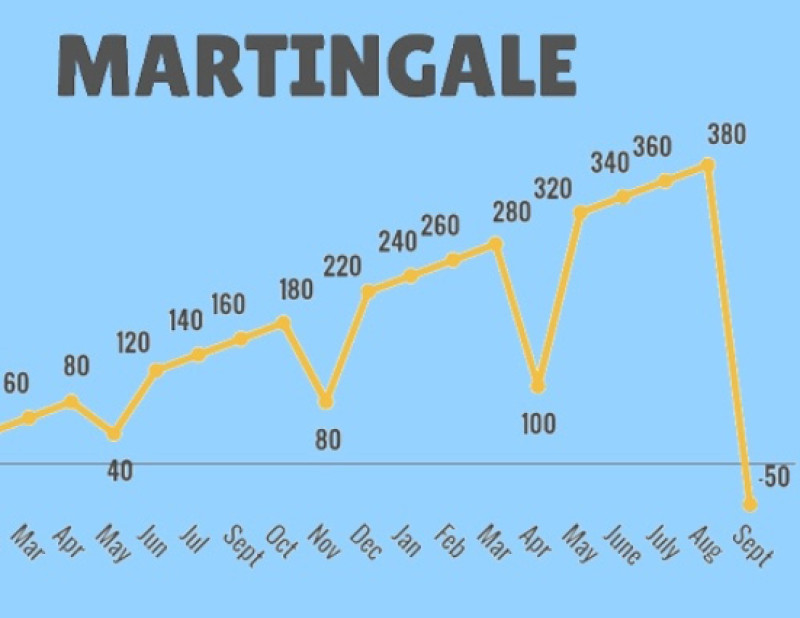
The logic of the system is simple. A positive result, as well as a negative one, corresponds to a probability of 50%. That is, either the trade on the upside will be profitable, or it will be losing again, doubling these losses.
The Martingale system assumes that absolutely all trades cannot be unprofitable, sooner or later, a trader will get profits. Based on the above, traders should correctly calculate the possibility of investment and wait for profits with the lowest possible level of losses.
In the mathematical sense, every losing trade brings profit in geometric progression. However, as practice shows, sometimes it is not possible to get real profits.
The Martingale system is very risky. It is not recommended for beginners. Experienced traders should test their strengths on a demo account before trading on a live account.
Traders who like this trading method should note that it is good only if they follow strict discipline and a number of rules. First of all, you should understand which losses will not lead to bankruptcy on your account.
Two questions before using the Martingale strategy:
- What to do if a trade turns out to be unprofitable?
- What do you do when your balance no longer allows you to open trades to recoup previous losses?
Basic rules when using Martingale method:
- You should open each next transaction with an amount that does not exceed the total trading balance of 1-5%. The maximum amount is an extreme case and is followed by a mandatory closing regardless of the final result.
- A series of 3-5 losing trades is a signal to stop trading at least until the next day.
- Trading should only be done with fixed volumes.
- The first profitable trade in a series of unsuccessful ones is a signal to return a minimum volume.
- The loss limit guarantees that you do not lose your capital. It should be set so that losses are not too large.
- The profit limit is a stop line, which will help to stop in time on a wave of success and not go to negative trading. It should also be set at a reasonable limit, without excessive overestimation.
If you follow these rules, you may avoid risks.
Example of calculation using the Martingale strategy
| No. | Volume | Potential profit |
| 1 | $10 | $10 |
| 2 | $20 | $10 |
| 3 | $40 | $10 |
| 4 | $80 | $10 |
| 5 | $160 | $10 |
The classic version of the Martingale strategy assumes doubling the total volume of a trade with the hope that the next one will bring profits. In this case, it will be possible to win back the losses and take profits.
Experienced traders prefer to use this strategy with other methods:
• The first option: trading from levels + Martingale. Notably, not every trade should be doubled, but only the one that resulted in a loss. In addition, trading from levels involves taking profit approximately three times the size of a stop-loss order, so it is not necessary to increase the transaction volume. It is quite reasonable to do it from time to time to get rid of or minimize the losses.
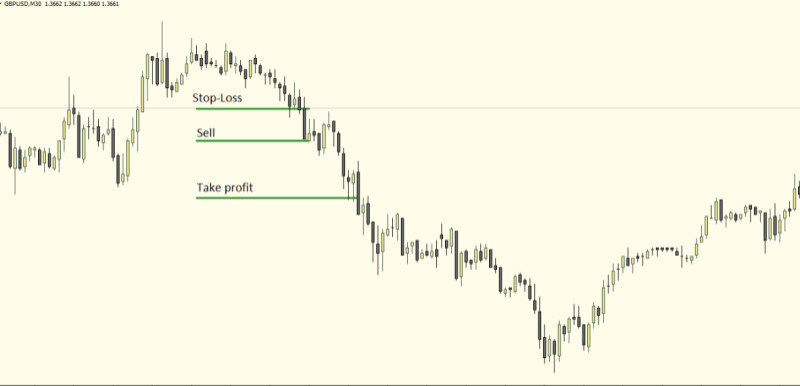
• The second option is to open a set of positions + Martingale. Here the work is as follows: the first position is opened with a smaller volume, then several more positions are added with the remaining volume if the price turns in the opposite direction. This allows you to achieve a lower average.
• The third option is to hold positions + Martingale. This is a classic strategy where the same or an increased number of positions are opened in the same direction betting that the market will reverse.
As for the effectiveness of the Martingale system, the market has a constant wave-like movement. This means that a wave in one direction is followed by a reversal and a wave in the other direction.
It does not matter whether it is a trend change or a temporary correction. From this point of view, the aggressive Martingale strategy has every chance of success. The main attention should be paid to the points of the beginning of a pullback or the formation of new trends.
However, we should not forget that sometimes there are situations when the price movement on the market is quite gradual without any bright reversals. Then Martingale can be a reason to lose the whole deposit because it is possible not to wait for the reversal.
How to trade using Martingale strategy
In probability theory, the Martingale strategy seems to be a random process, but in trading, it has a well-defined strategy. This method involves clearly defined actions.
The Martingale strategy implementation sequence:
- Choose a trading instrument. To get the best result, it is worth paying attention to the liquidity of the asset. It should be above average.
- Get acquainted with the economic calendar, and analyze the upcoming events. It is possible to achieve a positive result only in the absence of any significant news, which includes the publication of major statistics.
- Determine the direction of the price movement of the selected instrument.
- Find the most suitable entry point for opening a position. This can be done manually or through indicators or other tools.
- Set the total volume of the lot, depending on the available deposit. Here you should remember the important rules of risk management, which were presented above.
- Open a position based on the current trend.
- Place stop-loss and take-profit orders. They should be set on the following principle: the distance from the entry point should be the same in both directions. It will be possible to make adjustments along the way, which will increase overall profit.
- Open the next transaction if the previous one was losing. This process will be repeated until the profit is fixed. It is important to remember that after a profitable trade, it is necessary to start a new entry with the initial minimum volume.
Thus, the Martingale system will work until the trade is out of a losing position. This can be presented in more detail as follows:
- Entering the market
- The price reversal
- Loss accumulation on the trade
- Doubling the trade volume
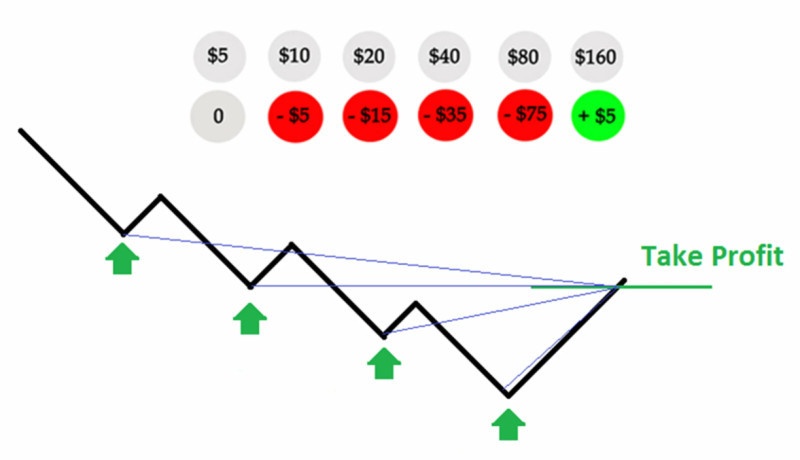
The classic version of the strategy began to change over time. The practical side of the problem showed that it is not necessary to double subsequent bets, but it is possible to triple them.
On the one hand, this makes your work more efficient when you win. On the other hand, losses are also tripled. Each trader decides whether this game is worth it or not.
In addition, the classic strategy assumes a return to the initial small trading volume after the first profit. Who is going to forbid you to continue opening positions with larger volumes? In this case, an investor takes all the risk.
However, despite all advanced Martingale methods, the strategy of opening trades remains the same.
How to open trades using Martingale method:
| Step | Description |
| 1 | After the first loss, the opening of a new trade takes place at some distance with the double volume |
| 2 | The break-even position is close to the second entry point, as it is opened with twice the size of the first entry point |
| 3 | Offset losses and close the position only when the price makes a short move in the direction of the opened position |
| 4 | If the price does not move in the expected direction, it is a new loss |
| 5 | You open a third position, the volume of which is doubled compared to the second one, and the break-even position is shifted again |
| 6 | If the price does not change its direction, the losses are growing |
| 7 | You open a fourth position doubling the volume of the third position. The break-even position shifts again |
| 8 | The price changes its direction. Your position moves to a break-even point and you can take profits |
Without the Martingale strategy it is practically impossible to win back four consecutive losing trades.
Important: It is not recommended to continue trading after five losing trades due to the increased level of risk and the possibility of losing your deposit.
A competent ratio of justified risk and technical analysis allows you to take advantage of this method.
When using the strategy, remember the following:
- This strategy should only be used by experienced market participants who use technical and fundamental analysis.
- The probability of losses is higher than in other strategies, so it is necessary to weigh the pros and cons beforehand.
- The method works best during the intraday period, it is not recommended to carry the trades to the next day, although it is not forbidden.
- It does not combine well with scalping.
- It is the easiest and most effective way to recover losses in a situation when the price moves in the opposite direction to forecasts and expectations.
- The strategy is used without stop-loss orders.
- In addition to doubling, other ratios are available, such as 1 to 3 or even 1 to 6.
Thus, the strategy is initially built not on getting the maximum profit, but on the wagering of the negative consequences with a minimum loss. A trader has no advantages, redistributing and postponing the profits.
If a loss occurs, it is definitely larger than usual. At the same time, the gain is insignificant in its volume.
Types of Martingale
As you can see earlier, Martingale is by no means inclined to a doubling of trade volumes. To win back the losses of previous trades is not its only goal.
Today, there are several types of this strategy, which differ from each other.
Features of Martingale strategy types:
1. Classic (standard) Martingale.
It has been described above. It implies that you double a trading volume after a losing trade.
This strategy was borrowed by the international market from the casino. In particular, such a principle was based on the game of roulette. After losing a bet on black, followed by a double bet in the same position. And so on until the failure is replaced by a success.
However, it is not a question of profit, but the return of lost money. In the case of the casino, there are a number of restrictions, including the number of bets and their maximum volume.
Forex markets also have their own limits, which largely determine the operation of the system itself. If there are no obstacles to increasing subsequent trades, the size of your deposit will act as a deterrent.
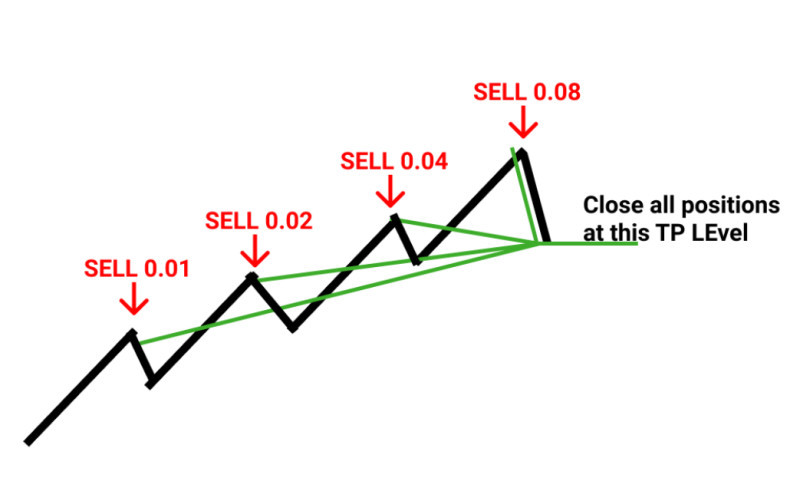
2. Aggressive Martingale.
The peculiarity: the use of not double, but triple the volume on subsequent trades. However, higher volumes are common. It is a take-it-or-leave-it situation.
This type assumes that you place a take-profit order as close as possible to the current price. Only then, your positions can be closed faster and easier.
This is an extremely dangerous method because it often happens that the price does not reach the target, reverses, and starts moving in the opposite direction. Almost immediately, the entire deposit is wiped out as losses begin to grow exponentially.
Only very experienced traders prefer this type of Martingale only in exceptional cases.
3. Reverse Martingale.
It is based not only on the gradual increase of the trade size but also on the same reduced use of a multiplier. It is not about a constant doubling of a trade volume, but about a fractional increase of it.
The scheme will be changed from 1-2-4-6 to 1-2-3-4. Thus, the burden on the deposit is reduced, as well as the risk of rapid loss of your capital.
4. Anti-Martingale.
This is the classic variant of the strategy, only in reverse. Doubling (or tripling) is not a losing trade, but a profitable one.
This is a safer type of strategy. At the same time, it can be difficult to implement for beginners. It is usually used by experienced traders who have developed their own stable strategy over the years.
Besides, the statistics of trading are important, it is necessary to use it when trading.
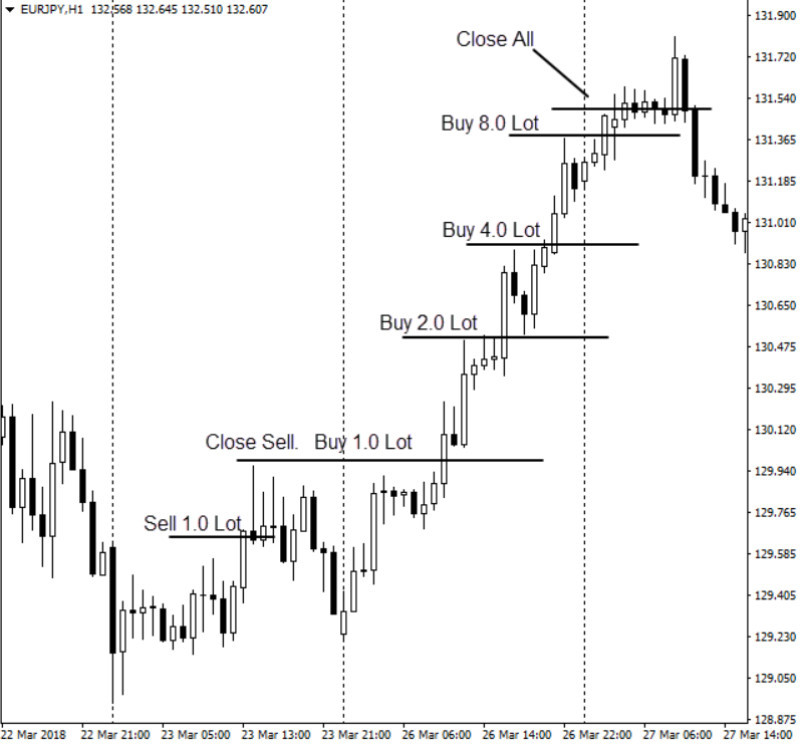
For example, your deposit is $1,000, the step is 1% of this amount, which is $10. The probable profit is $30. Only if the result is positive and the volume is doubled, i.e. the next step is not $10, but $20.
Thus, you do not risk your deposit, but only the profit. If it was not possible to get profits by doubling the trade size, you return to the initial volume of $10. This will happen every time you make a losing trade.
Important! If the trader's statistics do not show several profitable trades in a row, this strategy will not work effectively. In this case, it is better to use another type.
5. Positive Martingale.
This is the safest type compared to others. It is based on a limited number of attempts to recoup the incurred loss.
In most cases, the doubling (or tripling) stops after the third unsuccessful attempt to get a winning trade. If it has not worked up to that point, further action can only make the situation worse and create more problems.
To avoid losses, there is a return to the previous volume of the lot.
Important! In this case, the goal is not to get profits but to save the remaining deposit.
Whatever type of Martingale is chosen, it should be tested first on a demo account.
You should use this system wisely. Choose only good moments for entry, when the chance of successful trading is higher. If you suffer losses, stop using the chosen strategy.
Martingale method in crypto trading
From a theoretical point of view, the strategy is well suited for the investment market, which includes the cryptocurrency exchange. However, it requires a much larger deposit volume, as well as a careful check of each step.
From a technical point of view, Martingale in cryptocurrency looks as follows:
- A trader evaluates the market situation;
- Decides on further rise or fall of the cryptocurrency value (further actions on opening a trade depend on it);
- Makes an entry with the initial minimum step;
- In case of a loss, the trade is doubled; in case of a positive result, the trade is rolled back to the previous volume.
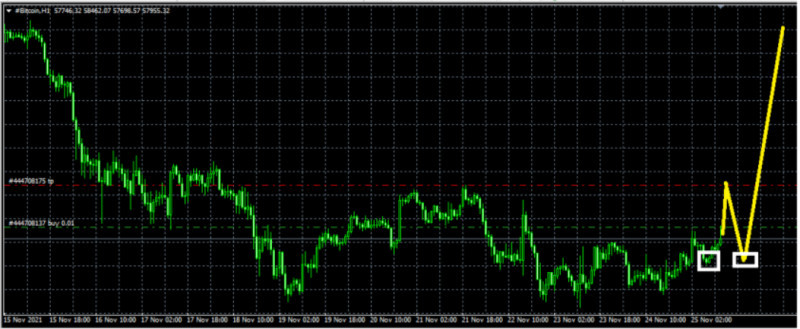
For cryptocurrencies, the system will work much more successfully if the asset has an equal chance of both growth and contraction. Then even high volatility will be balanced.
The main problem for traders applying Martingale for crypto is the size of the deposit. In fact, it should be much larger than on Forex. Recovery from losses will require large investments, which are not always recoverable.
Advantages of Martingale in crypto
- The strategy perfectly works with the standard movements of the cryptocurrency market. Especially high results can be achieved at the moment of transition from one phase to another. Initial large losses can be easily compensated at the moment of reversal and transition to a new trend.
- Choosing a cryptocurrency based on its characteristics allows you to assess it in more detail. This gives more guarantees when trading. In other words, trading is done with a more sober view of what is happening. Accidental and wrong choices are practically eliminated. So, losing an investment is less likely. In addition, crypto itself has value, which also allows you to save your deposit.
- The ability to transform the system to meet market demands. Particularly, many traders begin to abandon the elementary doubling of the lot, replacing it with a more complicated structure. Namely, a trade is made with the subtraction of the price from the previous doubled investment. This saves the deposit and reduces potential losses.
In general, Martingale is used quite successfully in the cryptocurrency markets. It works well in situations where you need to recoup your losses.
Novice traders can use the strategy. Experienced traders take into account the fact that the system has mathematical certainty.
However, crypto trading requires a larger deposit volume. Not every trader can afford it.
In any case, without preliminary training on a demo account, it is better not to start using Martingale on a live account.
Martingale not for everyone
The strategy has a number of features that make it impossible to recommend it to absolutely all traders. Sometimes, even investors with extensive trading experience abandon it in favor of other, more convenient, and less risky strategies.
You can understand whether this strategy suits you only after you try trading with it. On this basis, traders can be divided into two categories.
The first one considers it an excellent way out of a critical situation. The second one only points to the loss of their deposit and says that big losses are inevitable. Both are right in their own way.
Martingale is best for:
- Investor excitement. If a market participant wants to get more emotion out of trading - this system is quite suitable. Then the game, or rather the process itself, comes to the fore. The estimation of risks and losses is not taken into account and becomes secondary.
- Boost the deposit. In contrast to conservative methods, the system allows you to gain profit faster. However, the risks are high. There is a short period of time in which it is necessary to come out of the losses and achieve the profit.
- Professionalism. Only investors with extensive experience and well-developed trading strategies are able to keep the balance between possible capital loss and increased profit. As a rule, such investors use expert advisors.
Martingale pros and cons
| Pros | Cons |
| Does not require a detailed market analysis. Brings profit even without additional trading tools. | The need for an extended deposit. A losing trade will require doubling lots. Sometimes funds run out before the price turns in the right direction. |
| Simplified algorithm of actions. The main task of the trader is to choose the volume of the subsequent lot. The rest does not depend on the trader. | The necessity of detailed evaluation of the sequence of steps. In other words, a trader should think several moves ahead. A large number of losing trades can cause the trader to stop trading; therefore, he or she will have to accept the losses. |
| Eventually, the profit can be taken. The main task is to correctly distribute the deposit. | A significant psychological burden. The further the system trade advances, the more difficult the decisions are. The safety of the remaining deposit is at stake. |
| Impossibility to predict the number of losing trades. This should be accepted. | |
| A strong trend is the biggest danger for the investor. A long unidirectional price movement accelerates the loss of the deposit. | |
| A long series of unsuccessful trades makes compliance with the rules on risk reduction almost impossible. |
Martingale is characterized by more trades with losses than with profits. However, for traders with risk-management skills, this strategy can be quite useful.
Martingale without emotions
There are almost no ways to make Martingale's strategy safer. Every step is unpredictable.
However, by following a number of rules, you can avoid unnecessary losses.
Six recommendations for beginners
- Do not use Martingale during flats. This system is used at the beginning of a new trend, as well as against the background of its exhaustion. The best moment is when the trends change.
- Martingale should not be used as an independent and only strategy. Only in conjunction with technical and fundamental analysis, it can give a good result. Moreover, there should be a clear and consistent trading plan.
- It is possible to recoup losses more effectively if the volume of transactions increases smoothly and begins with the position with minimum volume.
- Never trade without stop-loss orders. Take-profit orders are not necessary but desirable. The subsequent transfer of it to a new position manually is acceptable. It is important to always keep in mind that a large volume can cause rapid loss of the deposit.
- Choose a time frame. Lower time frames do not suit forex trading as prices are not always predictable. Traders use a time frame higher than five minutes.
- Emotions are your enemy. Losses, especially large ones, cause a desire to win back quickly and fully. In this case, the overall situation is not always evaluated. Getting back what you have lost at all costs is not a good strategy. Sometimes, doubling or even tripling positions does not lead to the desired result. The only right decision is to stop trading in time.
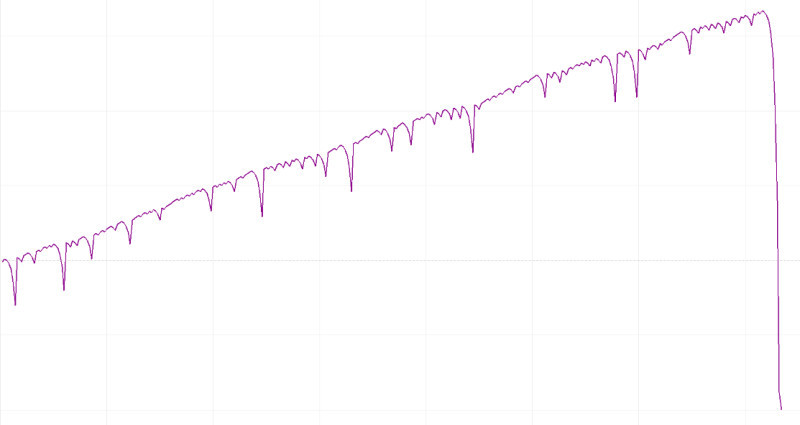
It is important to understand that the success of the Martingale strategy does not always depend on the trader's actions. Sometimes, it is better to retreat than to continue a pointless and unjustified struggle.
Conclusion
Martingale method is a specific strategy. At the same time, it has a high chance of bringing profits.
It is based on a mathematical model, which makes the system more reliable.
The main difficulties are, first, the impossibility of predicting the result. Second, it is the emotional factor. Thirdly, the high risk of losing the deposit.
As a result, it is recommended only in case of extreme necessity and taking into account the accumulated experience in trading. Beginners should leave this system in favor of safer methods.
The peculiarity of earning with Martingale is very limited profits combined with the risk of significant losses.
For a more detailed understanding of the strategy, we recommend that you test it on a demo account.
You may also like:









 Back to articles
Back to articles



